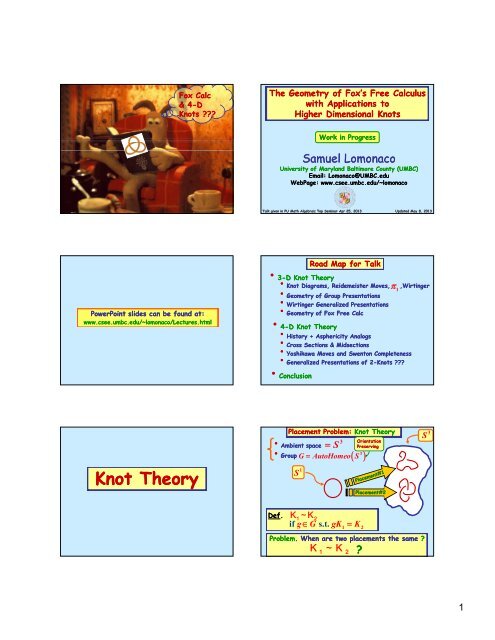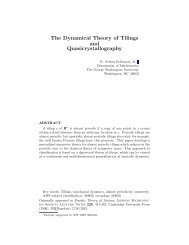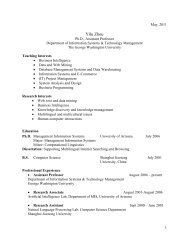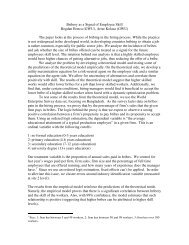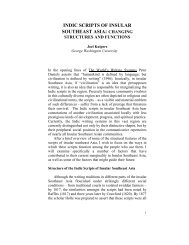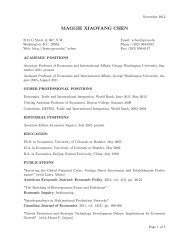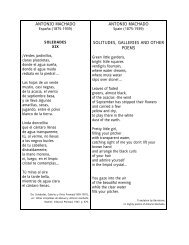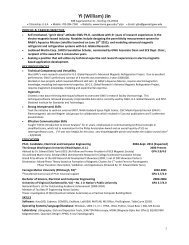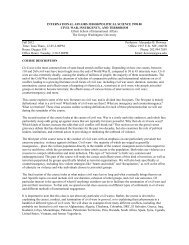Slides of the plenary talk by Samuel Lomonaco - GW Links
Slides of the plenary talk by Samuel Lomonaco - GW Links
Slides of the plenary talk by Samuel Lomonaco - GW Links
You also want an ePaper? Increase the reach of your titles
YUMPU automatically turns print PDFs into web optimized ePapers that Google loves.
Fox Calc& 4-DKnots ???The Geometry <strong>of</strong> Fox’s Free Calculuswith Applications toHigher Dimensional KnotsWork in Progress<strong>Samuel</strong> <strong>Lomonaco</strong>University <strong>of</strong> Maryland Baltimore County (UMBC)Email: <strong>Lomonaco</strong>@UMBC.eduWebPage: www.csee.umbc.edu/~lomonacoTalk given in PU Math Algebraic Top Seminar Apr 25, 2013Updated May 8, 2013Road Map for TalkPowerPoint slides can be found at:www.csee.umbc.edu/~lomonaco/Lectures.html• 3-D Knot Theory• Knot Diagrams, Reidemeister Moves, ,Wirtinger1Geometry <strong>of</strong> Group Presentations• Wirtinger Generalized Presentations• Geometry <strong>of</strong> Fox Free Calc• 4-D Knot TheoryHistory + Asphericity AnalogsCross Sections & MidsectionsYoshikawa Moves and Swenton Completeness• Generalized Presentations <strong>of</strong> 2-Knots ???• ConclusionKnot TheoryPlacement Problem: Knot Theory3Orientation• Ambient space SPreserving3• Group G AutoHomeo SGroup 1SPlacement#23SK ∼ KDef. 1 2if g G s.t . gK KK∼ K1 2Problem. When are two placements <strong>the</strong> same ?1 2?1
When do two Knot diagrams represent <strong>the</strong>same or different knots ?Theorem (Reidemeister).Two knotdiagrams represent <strong>the</strong> same knot iffone can be transformed into <strong>the</strong> o<strong>the</strong>r<strong>by</strong> a finite sequence <strong>of</strong> Reidemestermoves.Def.What is a knot invariant ?A knot invariant I is a mapI : Knots Ma<strong>the</strong>matical Domainthat takes each knot K to a ma<strong>the</strong>maticalobject I(K) such thatK ∼ K K K IConsequently, I 1 2 1 2IK K K ∼ K I 1 2 1 2The Fundamental Group 1 XKnot ExteriorX S SmallOpenTubularNbd kS3 1The Wirtinger Presentation• Fundamental Group1XKnot Invariant• Asphericity <strong>of</strong> Knots (Papakyriakopoulos) X K 1 X,1 . nX 0 for n1abc , , : r1, r2,r3GeneratorsRelatorsGroup PresentationsQuestion: When do two presentationsrepresent <strong>the</strong> same group ?Tietze Transformations:TT1Tietze 1: x : rx y : rs1: , where• yis a new symbol, and• s y 1, with Fx111 2, TT2 Tietze 2: x : r x:rs, wheremw• sConsr, i.e., s r , withj( ) 1•w Fx, 0 m, andw1• r j( ) wrj,( )w3
Group PresentationsQuestion: When do two presentationsrepresent <strong>the</strong> same group ?Theorem (TietzeTietze): Two group presentationsrepresent <strong>the</strong> same group iff <strong>the</strong>re exists afinite sequence <strong>of</strong> Tietze transformationswhich transforms one into <strong>the</strong> o<strong>the</strong>r.The Geometry <strong>of</strong> Group PresentationsDef. An abstract Group presentationconsists <strong>of</strong> two sets• x, <strong>the</strong> set <strong>of</strong> generators,• r, <strong>the</strong> set <strong>of</strong> relators,toge<strong>the</strong>r with an evaluation map^:r F xfrom <strong>the</strong> set <strong>of</strong> relatorsinto <strong>the</strong> freegroup on <strong>the</strong> set <strong>of</strong> symbols x.F xrThe Geometry <strong>of</strong> Group PresentationsThe Geometry <strong>of</strong> Group PresentationsExample:abc , , : r1, r2,r3, whereDef. A CW-complex is said to bemonopointed it it has only one 0-cell. 1 1r1 cbc arr23 aca b1 1 bab c1 1Proposition. Up to renaming andreordering, <strong>the</strong>re exists a one-to-onecorrespondence between <strong>the</strong> set <strong>of</strong>abstract group presentations and a set<strong>of</strong> monopointed 2-D CW-complexes.x : rKx:rThe Geometry <strong>of</strong> Group PresentationsThe CW-complexK x : yis constructedwith an initial 0-cell, denoted <strong>by</strong> , and<strong>the</strong>n iteratively attaching cells as follows:1-cells:For each generator j, adjoinan oriented 1-cellX j<strong>by</strong> attachingboth endpoints to <strong>the</strong> sole 0-cell .2-cells:For each relatororiented 2-cellmap .r kR krx x rk , adjoin anwith attachingExamplesTorus a, b : r , rababExample: P a, b : r , rababExample: 2 S D a, b: r , rbExample: 1 2 S S S a, b: r , r1Example: 1 1 2 S S : r , r , r 1, r 12 2 1 2 1 2Example: 4
Free-groupsThus, <strong>the</strong> elements <strong>of</strong> F t F x form:wt j( )F x are <strong>of</strong> <strong>the</strong>The Geometry <strong>of</strong> <strong>the</strong> Wirtinger Presentationw1wheret wj( ) tj( ) wj( )Note. This conjugation action is a leftaction.Wirtinger Generalized PresentationThe Wirtinger 3-D CW decomposition <strong>of</strong><strong>the</strong> exterior X is nothing more than <strong>the</strong>non-abelianfree resolution:^( , , ) FF1, 2,3^ F G F a b c r r r I^cbca r 1^acab r 2^babc r 3^ 2 1rrr1 2 3 ^1F^ Please note that and .IWirtinger Generalized Presentation^( , , ) FF1, 2,3We denote <strong>the</strong> above non-abelianfreeresolution more cryptically asabc , , : r, r, r:I1 2 3^ F G F a b c r r r Iand call it a generalized presentation.FWirtinger Generalized PresentationWirtinger Generalized Presentationabcd , , , : r1, r2, r3, r3:I^bcba r 1^cbcd r 2^daca r 3rrr ra c ca ca ^1 2 4 3 I^adbd r 46
Terminology for Generalized PresentationsThe current names identities, identities <strong>of</strong>identities, identities <strong>of</strong> identities <strong>of</strong>identities, etc. are too cumbersome. Sowe instead adopt <strong>the</strong> following terminology:generatorsor1-st orderrelators(2) (3) (4)x: r : r : r : 2-ndorderrelators3-rdorderrelators4-thorderrelatorsGeneralized Tietze MovesThere is only one generalized Tietze movefor each order, namely:n-thorder generalized Tietze move T n:( n) ( n1) ( n) ( n1) T : : r : r : : r : r :nwhereand where 1and F F r( n)Generalized Presentation EquivalenceThe definition <strong>of</strong> generalized presentationequivalence is a straight forward exercisefor <strong>the</strong> audience. So is <strong>the</strong> pro<strong>of</strong> <strong>of</strong> <strong>the</strong>following <strong>the</strong>orem:Theorem: Two generalized presentationsare equivalent iff <strong>the</strong>re is a finite sequence<strong>of</strong> generalized Tietze moves that transformone into <strong>the</strong> o<strong>the</strong>r.The Geometry <strong>of</strong> Generalized PresentationsProposition. Up to renaming and reordering, <strong>the</strong>reexists a one-toto-one one correspondence between <strong>the</strong>set <strong>of</strong> finite generalized presentations and a set<strong>of</strong> monopointedCW-complexes.x : r : r (3) : r (4) : Kx : r : r (3) : r(4): The generalized tietze moves correspond tosimple homotopy moves on <strong>the</strong> associated CW-complexes.Moreover, two generalized presentations defineCW complexes <strong>of</strong> <strong>the</strong> same simple homotopy typeiff <strong>the</strong>re is a finite sequence <strong>of</strong> Tieze moveswhich transforms one into <strong>the</strong> o<strong>the</strong>r.The Geometry <strong>of</strong> <strong>the</strong> Fox Free Calculus(2) (3) ( n)Let P x: r : r : :r be a generalized presentation, and letLet <strong>the</strong> fundamental group <strong>of</strong> .Letassociated withK KPbe <strong>the</strong> corresponding CW-complex.1G K: F x Gx : r (2)Gbe <strong>the</strong> epimorphismFinally, let be <strong>the</strong> group ring <strong>of</strong> over<strong>the</strong> integers .GKThe Geometry <strong>of</strong> <strong>the</strong> Fox Free CalculusLetKbe <strong>the</strong> universal cover <strong>of</strong> K, and letK KKerbe <strong>the</strong> non pathwise connectedspace above K.We now use <strong>the</strong> Fox free derivatives toconstruct a chain complex C C KHence,Moreover,* *H K H C* * *H *KH* G FC*7
The Geometry <strong>of</strong> <strong>the</strong> Fox Free CalculusThe chain groups are defined as follows:• The 0-th chain groupis defined0 0 as <strong>the</strong> free FC C( )-module generated <strong>by</strong> <strong>the</strong>0-cell .• For n > 0 , <strong>the</strong> n-thchain groupnis defined as <strong>the</strong> free F -module( n)generated <strong>by</strong> <strong>the</strong> set <strong>of</strong> n-cells .nC C RR( n)The Geometry <strong>of</strong> <strong>the</strong> Fox Free CalculusThe boundary morphisms are defined asfollows:• For n = 0( )0 1C Cn = 0 ,Xxj1 Xj• For n > 0( n1) ( n)n > 0 , Cn1R CnR( n) rj R( n1)k rk R( n1) ( n)kk xWhere <strong>the</strong> Fox Free derivativesare geometrically defined as follows:/jKKerUniv. CoverCW-ComplexComplexCell Decompositions <strong>of</strong>Epimorphism:KKKK, K,KF xG 1K(3) (4)w wXi wRj wRk wR4 (3) (4)g gXi gRj gRk gR4 X (3) (4)iRj RkR0-cells1-cells2-cells3-cellsg GwFx4-cells(2) (3) ( n)Recall x: r : r : : rand K K P.(2)If, for example, r rwith r x1x2x1x3,<strong>the</strong>n <strong>the</strong> corresponding 2-cell Rin KisP x1xX2 1x X1 2x 2x1 R x 1x3X 1 x1x2x1X31 1R xx1 2X1 xX1 2 xxxX1 2 3r r r X X Xx x x1 2 31 2 3xx1 3(3)x1x3If, for example, urwith ur1 r2r1, <strong>the</strong>n<strong>the</strong> boundary chain map <strong>of</strong> <strong>the</strong> corresponding 3-cell Uin Kis:U x r r x x r R rx Rx1 x3 x11 1 2 1 3 1 1 3 2^^u uR R r 1r 2 1 28
For completeness, we give <strong>the</strong> standardalgebraic definition <strong>of</strong> <strong>the</strong> Fox free / xjAlgebraic Def. <strong>of</strong> Fox Free Derivative / xjLet Gbe a group, and let Gdenote<strong>the</strong> corresponding group ring over <strong>the</strong>ring <strong>of</strong> integers .Def. A derivativein <strong>the</strong> group ringDGD : GGin <strong>the</strong> group ringis defined as a mapsatisfying <strong>the</strong> following condition:1)D D DD D D1) 2) o:1 2 1 2o1 2 1 21 2GGwhereis <strong>the</strong> trivializermorphism which maps each element <strong>of</strong>to 1 <strong>of</strong> .GAlgebraic Def. <strong>of</strong> Fox Free Derivative / xjG FxDef.(Cont.)Let be <strong>the</strong> free group .Then to each free generator xj x, <strong>the</strong>recorresponds a unique derivativeF xD /xjin, called <strong>the</strong> derivative withrespect to, which has <strong>the</strong> propertyx jxixj ijj(Kroneckerdelta)2-KnotsVarious Placement Problems• 3-D Knot Theoryk:S S1 3• 4-D Knot Theoryk:S S2 4• 5-D Knot Theoryk:S S3 51-KnotS, kS3 12-KnotS, kS4 23-KnotS, kS5 34-D Knot Theory (Incomplete) HistoryRoseman SchoolKnot ProjectionsE. Artin –Spun Knots2 DifferentApproachesFox SchoolKnot Cross SectionsD. Roseman - Proj. Moves R. Fox - Cross SectionsCarter & Saito – Proj. MovesMuch more …<strong>Lomonaco</strong> - Mid SectionYoshikawa – Y-MovesSwenton/Kearton/KurlinKurlin –Y-Moves Completeness9
4-D Analog <strong>of</strong> <strong>the</strong> Apspericity <strong>of</strong> Knots ?For 1-knots,asphericity implies <strong>the</strong> exteriorX is an Eilenberg-MacLanespace, i.e.,X K 1X,1Question. Want can be said about analog<strong>of</strong> Papa’s ashphericity <strong>the</strong>orem for 2-knots?4-D Analog <strong>of</strong> <strong>the</strong> Apspericity <strong>of</strong> Knots ?S , kS4 2Def. A 2-knotis said to be quasi-aspherical (QA) if <strong>the</strong> third homology group <strong>of</strong><strong>the</strong> universal cover <strong>of</strong> its exterior vanishes.Theorem. (<strong>Lomonaco</strong>) Ifis QA,<strong>the</strong>n <strong>the</strong> homotopy type <strong>of</strong> its exterior X isdetermined <strong>by</strong> its algebraic 3-type, i.e., <strong>by</strong><strong>the</strong> triple consisting <strong>of</strong>:• X 1 • X 2 as a X 1• The first k-invariant3H 1X;2XS , kS4 2-modulekXlying inEdwin Abbott’s FlatlandThe Cross sectionalApproach to 2-Knots3-D LandThe MidsectionRepresentation2-Knots10
Edwin Abbott’s Flatland3-D LandMidsection Labeling Scheme Midsection Representation <strong>of</strong> a 2-sphereMidsection Rep <strong>of</strong> a Spun Trefoil4 2Midsection <strong>of</strong> S , k ??? P11
Reidemeister MovesMidsectionMoves on2-KnotsYoshikawa MovesThe Geometry <strong>of</strong> Group PresentationsTheorem(Yoshikawa).The Reidemeisterand Yoshikawa moves on <strong>the</strong> midsectionrepresentation <strong>of</strong> a 2-knot preserve knottype.Theorem(Swenton/Keartin/Kurlin).Two 2-knot midsections represent <strong>the</strong> same 2-knotiff <strong>the</strong>re is a finite sequence <strong>of</strong> Reidemeisterand Yoshikawa moves which transforms oneinto <strong>the</strong> o<strong>the</strong>r.The Geometry <strong>of</strong> Group PresentationsThe WirtingerGeneralized Presentation<strong>of</strong>2-Knots ???UPOutDown12
Talk OverviewOpen Question 1This <strong>talk</strong> is a description <strong>of</strong> a researchprogram which is best summarized <strong>by</strong><strong>the</strong> following two questions:How does one piece toge<strong>the</strong>r <strong>the</strong>Wirtinger generalized presentations <strong>of</strong> all<strong>the</strong> exterior cross sections <strong>of</strong> a 2-knot4 2S, kS into a generalized presentation<strong>of</strong> <strong>the</strong> exterior <strong>of</strong> <strong>the</strong> entire 2-knot???Open Question 2Conclusion ???Given a generalized presentation <strong>of</strong> <strong>the</strong>4 2exterior X <strong>of</strong> a 2-knot S, kS , howdoes one read <strong>of</strong>f from this generalizedpresentation <strong>the</strong> second homotopy group X(as X -module), and <strong>the</strong> k-2 1 invariant 3??? ; kx H X X1 2The answers are …???UpcomingSpecial Issue<strong>of</strong>Journal<strong>of</strong>Quantum Information ProcessingonTopological Quantum ComputationGuest EditorsKauffman & <strong>Lomonaco</strong>14
Weird !!!This <strong>talk</strong> based on:<strong>Lomonaco</strong>, <strong>Samuel</strong> J., Jr., Five dimensional knot <strong>the</strong>ory,in "Low Dimensional Topology, AMS CONM/20,Providence, Rhode Island, (1984), pp 249 - 270<strong>Lomonaco</strong>, <strong>Samuel</strong> J., Jr., The homotopy groups <strong>of</strong> knotsI. How to compute <strong>the</strong> algebraic 3-type, Pacific Journal <strong>of</strong>Ma<strong>the</strong>matics, Vol. 95, No. 2 (1981), pp 349 - 390<strong>Lomonaco</strong>, <strong>Samuel</strong> J., Jr., Homology <strong>of</strong> group systemswith applications to low dimensional topology, Bulletin <strong>of</strong><strong>the</strong> American Ma<strong>the</strong>matics Society, Vol. 13, No. 3 (1980),pp 1049 - 1052.<strong>Lomonaco</strong>, S.J., Jr., The second homotopy group <strong>of</strong> aspun knot, Topology, Vol. 8 (1969), pp 95 - 98And also based on:Fox, R.H., A quick trip through knot <strong>the</strong>ory, in“Topology <strong>of</strong> 3-Manifolds and Related Topics,”ed. <strong>by</strong> M.K. Fort, Jr., Prentice-Hall, EnglewoodsCliffs, New Jersey, (1962), 120-167.Kearton, C. & V. Kurlin, All 2-dimensional linksin 4-space live inside a universal polyhedron,Alg. Geom. Top, 8, (2008), 1223-1247.Swenton, Frank J., On a calculus for 2-knotsand surfaces in 4-space, JKTR, Vol. 10, No. 08,(2001), 1133-1141.Yoshikawa, Katsuyuki, An enumeration <strong>of</strong>surfaces in four-space, Osaka J. Math. 31(1994), 497-522.Some O<strong>the</strong>r ReferencesArtin, Emil, Zur isotopie zweidimensionaler Flachen im R 4 , HamburgAbh. 4 (1925), 174-177.Carter, J. Scott, and Masahico Saito, Reidemeistermovesfor surfaceisotopies and <strong>the</strong>ir interpretations as moves to movies, J. Knot Theoryand Its Ramifications, 2 (1993), 251-284.Carter, J. Scott, Masahico Saito, “Knotted Surfaces and TheirDiagrams,” AMS, (1998).Fox, R.H., and J.W. Milnor, Singularities <strong>of</strong> 2-spheres in 4-space andequivalence <strong>of</strong> knots,Kamada, Seiichi, Surfaces in 4-Space: A view <strong>of</strong> normal forms andbraidings, in “Lectures at Knots ’96,” edited <strong>by</strong> Shin’ichi Suzuki, WorldScientific, (1997), pp. 39-71.Kawauchi, Akio, T. T. Shibuya, and S. Suziki, Descriptions on surfacesin four-space, I. Normal forms, Math. Sem. Notes, Kobe University, 10(1982), 75-125.Kawauchi, Akio, “A Survey <strong>of</strong> Knot Theory,” Birkhauser, (1990), pp.171-199.Some O<strong>the</strong>r References<strong>Lomonaco</strong>, <strong>Samuel</strong> J., Jr., Finitely ended knots are quasi-aspherical,"in "Algebraic and Differential Topology- Global Differential Geometry,"edited <strong>by</strong> George. M. Rassias, Teubner Publishers (Leipzig), Germany,(1984), 192 - 197.<strong>Lomonaco</strong>, <strong>Samuel</strong> J., Jr., The third homotopy group <strong>of</strong> some higherdimensional knots, in "Knots, Groups, and 3-Manifolds," (L.P.Neuwirth, ed.), Annals <strong>of</strong> Math Studies, 84, Princeton Univ. Press,(1975), 35 - 45.<strong>Lomonaco</strong>, <strong>Samuel</strong> J., Jr., The fundamental ideal and Pi2 <strong>of</strong> higherdimensional knots, AMS Proc., 88, (1973), 431 - 433.Andrews, J.J., and S.J. <strong>Lomonaco</strong>, Jr., The second homotopy group <strong>of</strong>spun 2-spheres in 4-space, Annals <strong>of</strong> Math., 90 (1969), pp 199 - 204.<strong>Lomonaco</strong>, S.J., Jr., The second homotopy group <strong>of</strong> a spun knot,Topology, Vol. 8 (1969), pp 95 - 98.Roseman, Dennis, Reidemeistertypemoves for surfaces in four space,preprintRoseman, Dennis, Projections <strong>of</strong> knots, Fund. Math. 89 , no. 2, (1975),pp. 99-110.15


